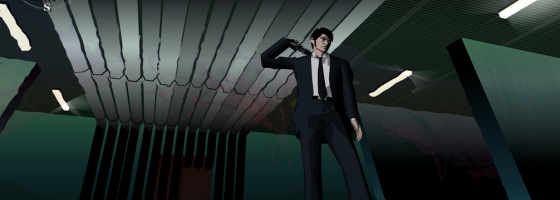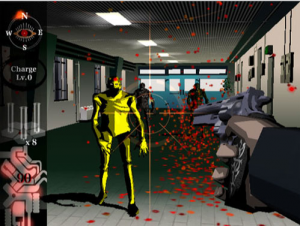Last week’s kickstarter spotlight for the Untold Story of Japanese Game Developers gave me an idea for another blog series. For this one, I want to talk about some of my favorite games from Japan. To make things interesting, I’m not going to talk about those that I’ve already featured in one way or another. Meaning no Xenoblade Chronicles, Demon’s Souls or The World Ends With You.
Let’s begin with one of the craziest games on the Gamecube that introduced Western gamers to the man known as Suda 51.
Killer 7:
During the Gamecube generation, Capcom announced the “Capcom 5” — five uniquely designed games that would appear on the Gamecube first. Some like P.N. 03 didn’t make a huge splash, while Viewitful Joe became a major hit. But the game that was surely the craziest was Killer 7.
Killer 7 went through numerous revisions and edits, with an ever changing storyline. The only common element was the game’s striking visual style: which combined cel shading with the sharp lines seen in a comic book style that to this day still stands out as something incredible.
When Killer 7 was finally released it was a game that was hard to explain both narrative wise and gameplay. The story involved a man with multiple personality disorder who could physically transform into any of his 7 personalities or as they were known: “The Smith Alliance” using the power of television.
Each character was completely unique and really could have existed in a separate video game. Some examples were the masked wrestler — Mask De Smith, to the silent knife-wielding albino assassin Kevin Smith. The Smiths were set up against the terrorist group: Heaven Smiles who were suicide-bombing monsters who were invisible to the naked eye.
The storyline as you could tell was pretty crazy as the Smith Alliance moved from locale to locale dealing with everything from assassins to black market organ sellers and even a battle with a Power Rangers parody. While the story was sure to keep you guessing, what hurt Killer 7‘s appeal was the gameplay that simply couldn’t match the outrageous story.
Every level was designed around the player being on fixed paths, with the player changing paths at specific branch points.
When the player encountered any of the heaven smiles, they would go into first person view to attack them. The key was that every enemy had a glowing weak point that when shot would be a one-hit kill.
Finishing off enemies would reward the player with blood that was used to upgrade characters. Killing an enemy via the weak point would reward more blood. To prevent the player from getting too strong, every level had a set amount of blood that could be used for upgrades.
Every enemy in the game attacked through coming in contact with the player, which made combat predictable after a while. However, every level had one unique smile and boss to deal with to mix things up.
The rest of the gameplay was about exploring the environment for keys, puzzles and special items to unlock the boss. Each character had special abilities that would be called upon at specific points and you would start each level with a different Smith.
The boss fights were the best parts of the gameplay of Killer 7 as this is when the player would be tested. One of the most tense boss fights I’ve ever played came from Killer 7. This boss attacked you in a maze of ambulances and you had to get around his body to attack his floating head that trailed a few feet behind.
You only need one shot to finish the boss, but if you missed the body would be alerted and would come after you. And if the body touched you it would be a one-hit kill.
Killer 7 was not a huge success, the limited gameplay and weird story didn’t win the game a lot of fans. However, the game’s unique style resonated with gamers who were looking for more mature titles for the Gamecube and the game became a niche hit.
This in turn opened the door for more games from Suda 51 to be ported to the US, including Lollipop Chainsaw, No More Heroes, Shadows of the Damned and his upcoming game: Killer is Dead.
The gameplay from Suda 51’s games has never been truly amazing, but the style injected in each has helped made his titles greater than the sum of its parts.
One last point, for those interesting in trying out Killer 7 after reading this, I suggest getting the Gamecube version of the game if possible, as people reported slowdowns and long load times on the PS2 version.
Up Next: A Trip To Shigeru Miyamoto’s Garden


